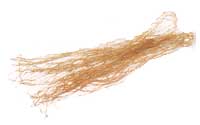
Asian Online Recipes (Food Glossary)

|
|
|
|
|
|
A B C D E F G H I J K L M N O P Q R S T U V W X Y Z
| Kaffir Lime Leaves | Lime leaves are responsible for the tangy, citrus perfume of many Thai soups, salads, stir-fries, and curries. Leaves have an explosive fragrance, cleanly floral and citrus – not quite lemon, not quite lime. Their aroma and flavor are assertive and lingering, yet delicate. The rind of the fruit is slightly bitter with a strong citrus note. Dried leaves and dried rind lack the intense aroma of fresh. |
 |
| Kai Lan | Also known as Chinese broccoli or Chinese kale. It has smooth, round stems sprouting large dark green leaves and small, white flowers. The juicy stems, trimmed of most of their leaves, are the piece of the plant which is most commonly eaten. Kai Lan has a similar flavor to Western broccoli, but without the characteristic large flower heads. |
 |
| Kecap manis | Also known as sweet soy sauce. This thick, dark and sweet soy sauce is used in Indonesian cooking as a seasoning and condiment, particularly with satays. If it is not available, a substitute can be made by gently simmering 1 cup dark soy sauce with 6 tablespoons treacle and 3 tablespoons soft brown sugar until the sugar has completely dissolved. |
 |
| Ketumber | See Coriander seeds | |
| Kewra Water | This is an extract that's distilled from the pandanus flowers and is used to provide flavors for meat, drinks, and desserts in India and Southeast Asia. | |
| Khoya | A daily product used mainly in making many sweets dishes. It is also considered to be one of the most important dairy products in many houses and is very commonly used in India. It is prepared by boiling and reducing the milk to a semi-solid stage. | |
| Korean vermicelli | See Noodles, Potato starch |
 |
|